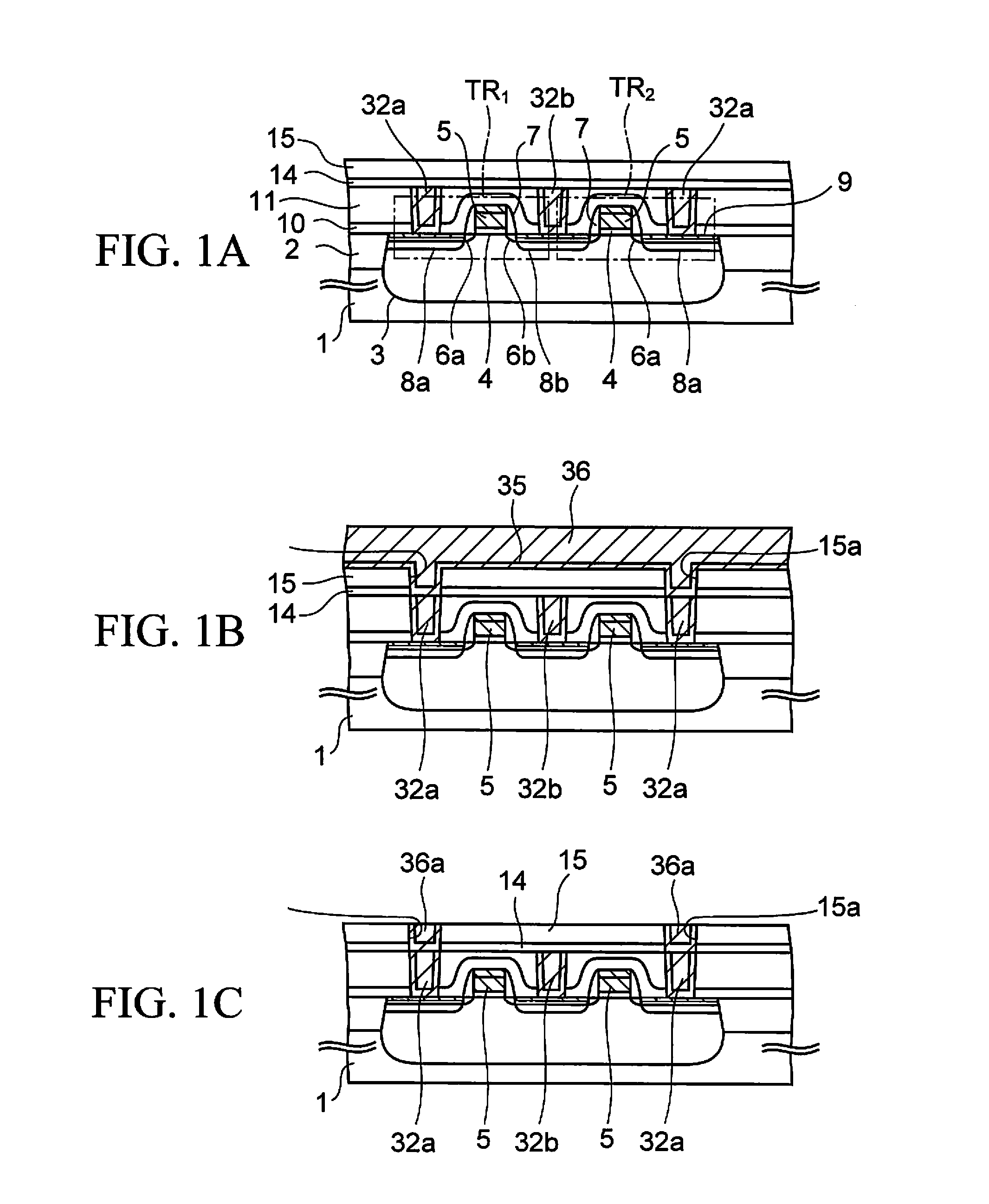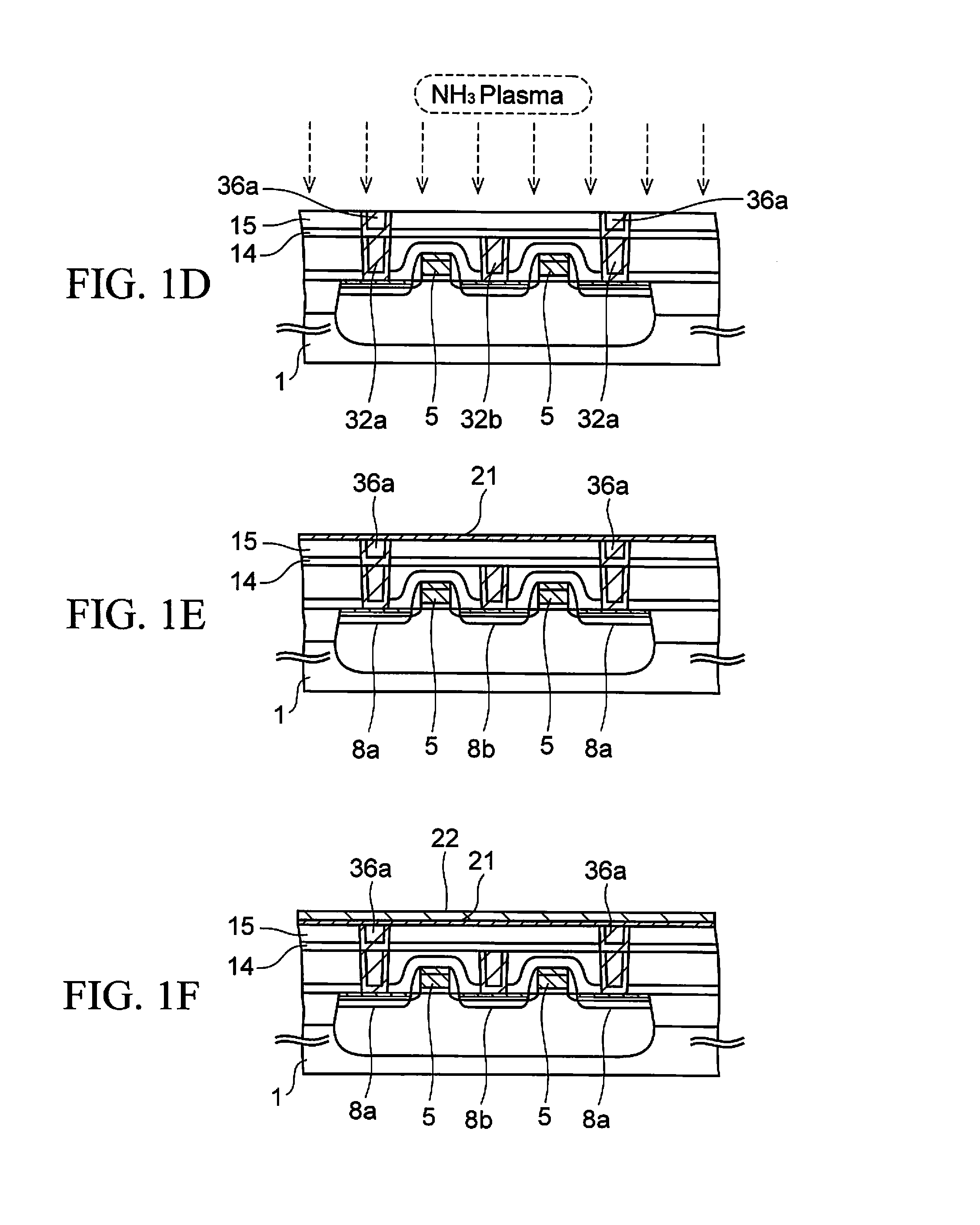Method of manufacturing semiconductor device
a manufacturing method and semiconductor technology, applied in capacitors, electrical appliances, capacitors with voltage varied dielectrics, etc., can solve the problems of flash memory, inability to meet the demand for higher performance of ferams, and relatively high voltage, so as to prevent the deterioration of ferroelectric characteristics and less prone to generation of hydrogen
- Summary
- Abstract
- Description
- Claims
- Application Information
AI Technical Summary
Benefits of technology
Problems solved by technology
Method used
Image
Examples
first embodiment
(1) First Embodiment
[0040]FIGS. 1A to 1W are cross-sectional views of a semiconductor device according to a first embodiment in the process of being manufactured.
[0041]This semiconductor device is a stack-type FeRAM advantageous in miniaturization, and is fabricated as follows.
[0042]At the beginning, steps for obtaining the cross-sectional structure shown in FIG. 1A will be described.
[0043]First, on a surface of an n- or p-type silicon (semiconductor) substrate 1, a groove for shallow trench isolation (STI), which defines an active region for transistors, is formed, and the inside of the groove is filled with an insulating film made of silicon oxide or the like which is used as an element isolation insulating film 2. Incidentally, an element isolation structure is not limited to STI, and the element isolation insulating film 2 may be formed by local oxidation of silicon (LOCOS).
[0044]Next, a p-type impurity is introduced into the active region of the silicon substrate 1 to form a p-...
second embodiment
(2) Second Embodiment
[0223]FIGS. 11A to 11L are cross-sectional views of a semiconductor device according to a second embodiment of the present invention in the process of being manufactured. Incidentally, in these drawings, elements described in the first embodiment are denoted by the same reference numerals as in the first embodiment, and will not be further described below.
[0224]In the step of FIG. 1C of the first embodiment, the third conductive plugs 36a are formed by polishing the glue film 35 and the plug conductive film 36 by CMP.
[0225]However, for the slurry used in the CMP, the polishing speeds of the glue film 35 and the plug conductive film 36 are faster than that of the underlying insulating film 15 thereunder. It is therefore difficult to align the heights of the respective upper surfaces of the third conductive plugs 36a and the underlying insulating film 15 with each other at the time when the CMP is finished.
[0226]Accordingly, as shown in FIG. 11A, recesses 15b are ...
third embodiment
(3) Third Embodiment
[0257]FIG. 12 is a cross-sectional view of a semiconductor device according to a third embodiment.
[0258]The third embodiment differs from the second embodiment in the following point. In the third embodiment, in the CMP step of FIG. 11D, the planarization conductive film 50 is removed from the upper surface of the underlying insulating film 15 to leave the planarization conductive film 50 only in the recesses 15b. The third embodiment and the second embodiment are identical except for the above points.
[0259]Also in the third embodiment, the capacitor dielectric films 24a are formed of the first ferroelectric film 24b and the second ferroelectric film 24c, and the first ferroelectric film 24b is annealed in an atmosphere containing an oxidizing gas, e.g., a mixed atmosphere of oxygen and argon.
[0260]Thus, impurities such as carbon and water in the first ferroelectric film 24b are removed, and it is made possible to simultaneously achieve an increase in the switchi...
PUM
| Property | Measurement | Unit |
|---|---|---|
| temperature | aaaaa | aaaaa |
| temperature | aaaaa | aaaaa |
| temperature | aaaaa | aaaaa |
Abstract
Description
Claims
Application Information
 Login to View More
Login to View More - R&D
- Intellectual Property
- Life Sciences
- Materials
- Tech Scout
- Unparalleled Data Quality
- Higher Quality Content
- 60% Fewer Hallucinations
Browse by: Latest US Patents, China's latest patents, Technical Efficacy Thesaurus, Application Domain, Technology Topic, Popular Technical Reports.
© 2025 PatSnap. All rights reserved.Legal|Privacy policy|Modern Slavery Act Transparency Statement|Sitemap|About US| Contact US: help@patsnap.com



